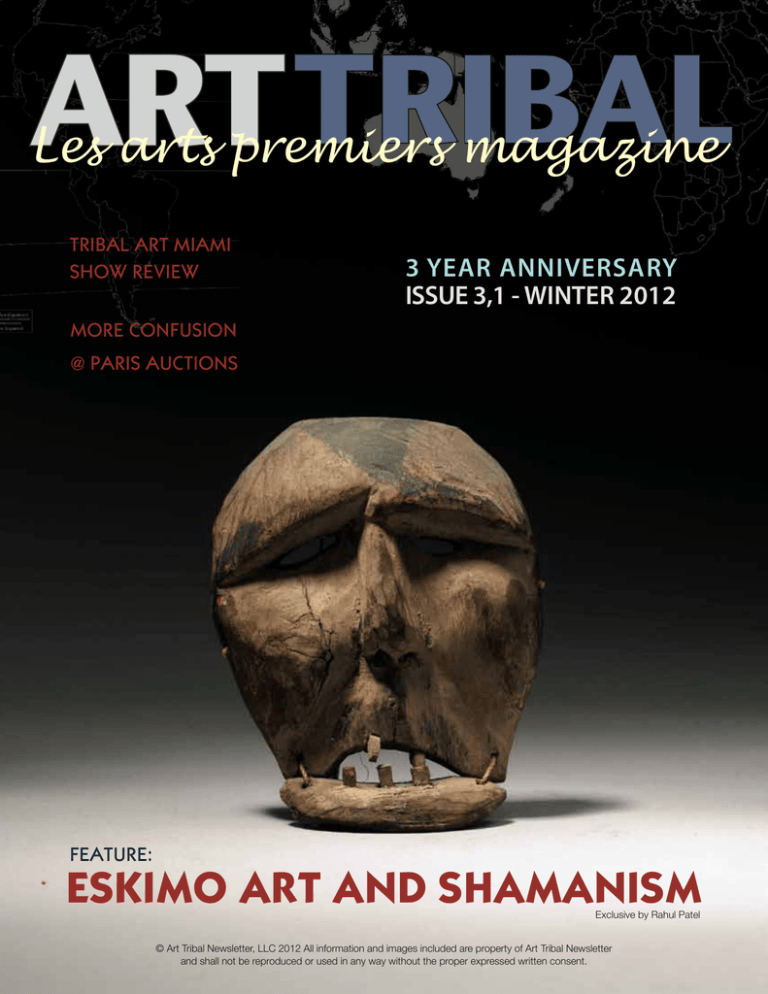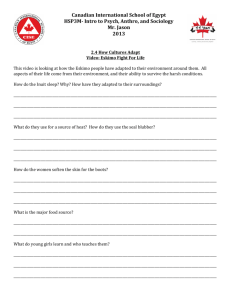Les arts premiers magazine ESKIMO ART AND
advertisement

Les arts premiers magazine Tribal Art MIAMI Show Review 3 YEAR ANNIVESARY 3 YEAR ANNIVERSARY ISSUE 3,1 - WINTER 2012 ISSUE 3,1 - WINTER 2012 mORE conFUSION @ Paris auctions www.arttribalnews.com www.arttribalnews.com feature: ESKIMO ART AND SHAMANISM Exclusive by Rahul Patel © Art Tribal Newsletter, LLC 2012 All information and images included are property of Art Tribal Newsletter and shall not be reproduced or used in any way without the proper expressed written consent. cassera ARTS PREMIERS more Auction price CONFUSION?!? As soon as we thought we had things figured out Sotheby’s goes and confuses the entire world once again. There are no words to describe the auction results from December’s Paris sale. The buyers of these objects are clearly not interested in art, they are not investors and provenance is obviously not a factor. So who are these buyers who pay $1M for a 3 inch ivory pendant? How does a failed auction that sells less then 20% of the lots still achieve a total of almost 10M EUROS? I guess we will never know the answer to these questions. Until then we invite you to ponder the following, enjoy. What’s the difference? LOT 42 168,000 EUROS! LOT 43 Two Mbum scepters from Cameroon, identical provenance, a 1 inch size difference, Lot 42 216,750 EUR, Lot 43 sold for 48,750 EUR. sold for Does provenance REALLY matter? COMBIEN????? 780,750 EUROS! Over $1M USD!!!! Skagit Squadeelish (Speakers Staff) Origin: Northern Washington State Circa: Mid to Late 19th Century Height: 29 in (74cm) Materials: Wood, shell, pigment Provenance: Private WA Collection Lot 21 A nice Senufo mask Coast, Hungaan ivory pendant from the Democratic Republic of the Congo, 3 1/8 in tall, NO PROVENANCE! Sold for over $1M USD, VERY CONFUSING! from the Provenance: Frédérick H. Lem entre 1934 et 1935, Collection H ele n a Rubinstein Paris - New York! This piece sold for the humble price of NEW YORK CITY & LACONNER WASHINGTON 719 1st Street Laconner, wa Phone: 212-873-1937 Mobile: 310-801-9324 www.casseraartspremiers.com <---- ACTUAL SIZE!!!! Ivory 15,000 EUR! 10th - 13th May Bohemian national hall 321 E 73rd St. New York, NY 10021 (3 blocks from Sotheby’s) During the 3rd Annual NYC Tribal Art Week™ For more info visit www.newyorktribalart.com or call 212-873-1937 ESKIMO ART AND SHAMANISM BY RAHUL PATEL Shamanism is an anthropological range of belief and practices which communicate with the spirit world. Shaman comes from the Tungus word called shaman - who can see in the dark. The word shaman originates from Sanskrit language Srama, meaning religious exercises, which became shamen in Chinese, meaning Buddhist monk. In Eskimo culture Shamans are called Angakoq; they are messengers between human world and spirit world. They treat illness by mending the soul, alleviating traumas affecting the soul or spirit, restoring the physical body and soul to wholeness. Alaska, the hub of Eskimo art in the contemporary age, was indeed the center where prehistoric Eskimo art reached its zenith. The North Alaskan art of the last 2000 years was the inspiration from which the contemporary Eskimo culture of Alaska, Canada, as well as Greenland, grew. Japanese boxwood okimono depicting According to the Eskimo belief system, Ashinaga and every object, the universe and cosmos Tenaga, Meiji Period is throbbing with life force called inua. (1868-1912) Inua can transform into a multitude of physical forms. A person may catch just a glimpse of the human-like face of inua. Acquiring and Selling Tribal Artifacts from a wide range of sources including; regional, national, and international galleries, private dealers, and works for resale from auctions, individuals and corporate clients. Image 1: cover and right - Eskimo Polychrome Wood Maskette is a prime representation of such inua. It was acquired in 1923, Museum of the American Indian, Heye Foundation and later by Smithsonian Institution. Later this coveted maskette was acquired and gave tremendous inspiration to surrealistic artist, Enrico Donati, in New York, who lived to the ripe age of 99 5757 Horton Street, Emeryville, CA 94608 USA zentner@zentnercollection.com, P: 510-653-5181 w w w. z e n t n e rc o l l e c t i o n . c o m www.tribalarthunter.com stacey@tribalarthunter.com Phone: (954) 683-4217 years, surrounded by Eskimo and Hopi figures in his studio to bring “mystery Image 1: Eskimo Polychrome Wood Maskette 1880 5 3/4 in. Ex 1923, Museum of the American Indian, Heye Foundation, Ex Smithsonian Inst. Ex Studio of Enrico Donati, Ex Sothebys and magic of the unknown”. I believe such … However, masks were widely used for curing The common myth among the connoisseurs shaman and his helping spirits to help remove art a unique gift to world culture. It is recently Eskimo mystical masks kept him excited with in the North, though apparently reserved only and experts of Eskimo art is that the illness, Jeffrey Myers, one of the world’s coming to be recognized as one of the most joie de vivre. The celebrated artist, Donati, for cases that had wider implications than a magical powerful figures called Dolls, are foremost Eskimo art authorities, believes. original, pioneering and visionary arts. There used to say, “I believe it’s another world. This simple illness. …The shaman most commonly playthings for the children, which according is no becoming. It is just being where all the is my world and the one outside I don’t even used masks to consult with spirits at a time of to my research are not playthings but have The shamanic ability of Eskimo art to soul think about when I work.” crisis, wearing a spirit mask to investigate the apotropaic purpose, “…such beautiful pieces In Eskimo culture “Masks were worn far more in cause…” Dorothy Jean Ray, Eskimo Masks; cannot have been used simply as children’s Art and Ceremony, pp. 17-19. dolls in the manner described… ”They were “… festivals dancing than in shamanistic activities, travel, going to the moon and back, shaman’s ability to fly in different worlds and times, their connection with cosmology, makes Eskimo multitudes co-exist together in their inuas. I All Art Objects From The Collection of Rahul Patel Photographs: Okvik figure, Shamanic Ipiutak Amulet, by Maureen Clark can experience their spirit world of Eskimo Eskimo Polychrome Wood Maskette, courtesy art where Angakoq is not only the master of Sotheby’s. space, but indeed, master of spirits! protecting against disease, serving as fertility and birthing amulets, and acting as general household guardians and deities.” Gifts from the Ancestors Ancient Ivories of Bering Strait, Fitzhugh, Hollowell, Crowell, pp. 292, Figure 3. figure, Okvik. Image 2 is such a depiction of this powerful anthropomorphic Okvik ivory figure, 250B.C. – 100A.D., excavated on St.Lawrence Island, Alaska and acquired from Cassera Arts Premiers Gallery in LaConner, WA. The ethnographic information, coupled with the figure’s remarkable beauty and surrealistic style suggest a complex and important role for Okvik human figures in ancient Bering Strait culture. Another unique Eskimo art form comes from Ipiutak culture, which is deeply connected with Shamanism. Their magical abilities to transform from humans to animals and animals to humans is astonishing. The epitome of this shaman’s transformative art was recently acquired by prolific and pioneering Eskimo art expert and field 3 5 collector, Jeffrey Myers of New York. It is an important shamanic object excavated at Point Spencer, Seward Peninsula. The object is a walrus ivory apotropaic effigy consisting of five distinct faces and a rendering of a shaman in flight. This rare healing object is from the Ipiutak culture, 400-600A.D. “…in the 30 years of my field collecting, I have never seen an effigy object so shamanic in nature.”- Jeffrey Myers. Images 3, 4, 5 are a visual, study in transformation – the shaman in various human forms and animal interchanges of inuas, transitions, passages and boundaries. This Ipiutak object is undoubtedly a curing 4 piece, bringing together the power of the Image 2: Okvik Ivory Anthropomorphic human figure excavated on St. Lawrence Island, Alaska, 250 B.C.-100 A.D., 4.5 inch. height, provenance ex Bill Caskey, ex Cassera Arts Premiers, New York & LaConner, WA Image 3: Rare Ipiutak Excavated Shamanic Eskimo Ivory Amulet 400-600A.D. 2 3/4 inch. Provenance Jeffrey Myers, New York. Image 4: Shaman transforming into polar bear on bottom of this Eskimo effigy and on the top is Shaman’s head in profile. Image 5: On the back of this apotropaic piece, shaman interchanging his human form into wolf Inua and wings to fly. AOA Tribal art: Hottest ticket in miami first ever tribal art show during Art basel makes it’s mark The first tribal art show ever to happen in Miami during Art Basel officially opened on schedule, Wednesday November 30th, the same night as Art Basel. While it was a small crowd in comparison to the major shows in Miami, AOA Tribal Art Miami only seemed to attract local collectors, famous artists, curators and press. Also attending over the four day show were actors, doctors, architects, engineers and other professional types, each noting the impressive venue and unique layout specifically designed for the Carnival Studio Theater inside the Adrienne Arsht Center for the Performing Arts. Participating dealers included; Wayne Heathcote - UK, Throckmorton Fine Art - NY, Luz Miriam Toro - NY, David Cassera - NY/ LaConner, James Stephenson - Brooklyn and Tribal Art Hunter - South Florida. Opening night sales were recorded by David Cassera and James Stephenson. Nine sales were recorded on day one with a staggeringly low attendance of just over 25 people. Attendance increased days two, three and the final Sunday and so did the sales. An African art collector attending from North Carolina was asked how he was enjoying the Art Basel festivities, when he sharply replied, “I only came to Miami specifically for this Tribal Art show.” While the other major established shows recorded tens of thousands of visitors, Tribal Art Miami remained very exclusive. Those attending remarked about the convenience of the show location, the free parking and lack of frustrating traffic and crowds experienced at the other shows like Art Miami, Scope and Red Dot. Overall the organizers, participants and patrons were very happy with the outcome. “I had a great time and you guys did a great a job on making this show,” said James Stephenson. The organizers have already joined forces with local museums and organizations to increase the publicity and programming for next years event. Co-owner Isaiah Fox said, ”this was the first time anyone has ever successfully organized and produced a Tribal Art Show in Miami. The fact that we did it during Art Basel with so much going on was a major accomplishment. We are eager for next year and are confident our brand will grow here in South Florida which is very exciting!” IMAGES: Above - View of Tribal Art Miami from the control room above. Opposite Top Left - Attendees admire Songye mask from Cassera Arts Premiers Opposite Top Right: Spencer Throckmorton with visiting medical doctors interested in collecting tribal art Opposite Lower Left: James Stephenson from Brooklyn with an ancient iron currency which was sold to a couple from Miami/NY Opposite Lower Right: A pair of fern figures presented by UK based dealer Wayne Heathcote.


